Pro Tip: Planning to visit the Louvre in Paris? Bookmark this post in your browser so you can easily find it when you’re in the city. Check out our guide to Paris for more planning resources, our top Louvre tours for a memorable trip, and how to visit the Louvre.
The 17 Most Famous Paintings at the Louvre
Art is about emotion. It’s the result of an artist unleashing their innermost thoughts and feelings onto canvas for all to witness, but which few understand. If you look at a painting and don’t feel anything, it’s because you’re lacking its backstory and historical context—the very reason we recommend taking guided tours.
If you hear the story and don’t get chills, then the artwork may have failed in its purpose to inspire emotion. You don’t have to have a long art background to appreciate art, but you would greatly benefit from having a guide with a long art background skilled in the art of storytelling. This article is not meant to replace a tour—it will prepare you with a solid background to make a tour even better.
Check out our Louvre tours and Paris tours led by the city’s most passionate guides! To find out more about what to see and how to visit the Louvre, explore the menu below:
Not ready to book a tour? Find out if a Louvre Museums tour is worth it.

Watch this video on YouTube
17. St. Francis of Assisi Receiving Stigmata
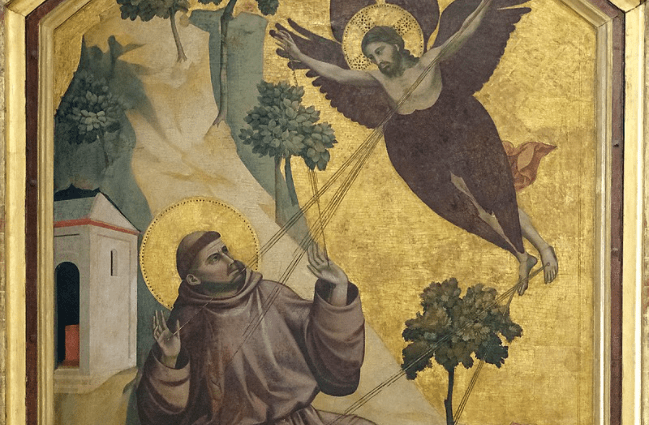

Giotto di Bondone | 1295 – 1300 | Tempura on Wood | Denon Wing, Room 708
If you’re familiar with the Byzantine art style, you may agree that it can be a little boring. The art style relies on “stiff” figures who lack emotion. You can easily identify Byzantine art as it relies heavily on gold leaf, as seen above. If you’ve seen one Byzantine painting, then you’ve seen them all, which is why I admittedly celebrate the last one ever painted.
Giotto’s St. Francis of Assisi Receiving Stigmata is not actually the last Byzantine painting ever painted, but it is the beginning of the end of this art style. Giotto introduces figures with more emotion that interact with one another and tell a defined story. This theme would become the backbone of the Renaissance.
Stand in front of Giotto’s St. Francis of Assisi Receiving Stigmata and you can easily compare it to the other Byzantine art in the same room of the Louvre. Notice that Giotto’s figures interact more with one another, show a bit of emotion, and weave a slightly more passionate story.
Giotto would go on to fresco the Scrovengi Chapel, which was full of color and told an immense story. The chapel brought art one step closer to the Renaissance, which produced some of the world’s most famous artwork—much of which is in the Louvre.
This painting is the first on my list because it’s part of an arts resurgence and the reason why the Sistine Chapel, Mona Lisa, Last Supper, and Liberty Leading the People would come to exist. The work is an artist making a considerable attempt to reinvent art and break it out of its box.
16. The Rape of the Sabine Women


Nicolas Poussin | 1637-38 | Oil on Canvas | Richelieu Wing, Room 828
Nicolas Poussin was an Italian from another mamà. He was born in Normandy and schooled in France, but lived most of his adult career in Rome, which he adored.
The Rape of the Sabine Women is possibly the most famous story in Roman history other than the murder of Julius Caesar. Poussin’s version of it is a testament to the artists’ love for Rome and one of the most famous versions of the scene ever painted.
The Romans had a shortage of women and none of the nearby tribes would assimilate out of fear of the Romans growing too strong. Romulus, the first King of Rome, decided to throw a party and invite the nearby tribes, which were heavily attended by the Sabine people. On Romulus’s signal, who is painted with a red cape and gold armor, the Romans abducted the Sabine women to take them for their wives.
The women would give birth to the second generation of Roman sons who would perpetuate the longest-lasting and arguably the greatest empire in European history. The significance of the story is that the empire began with pain and wrong-doing as a means to an end.
This harsh mentality would become intertwined with Roman pragmatism throughout the empire’s growth. Right or wrong, they took what they needed and made up for it later. Poussin captures this all beautifully in Italian Renaissance fashion.
Our Best Versailles and Paris Louvre Tours
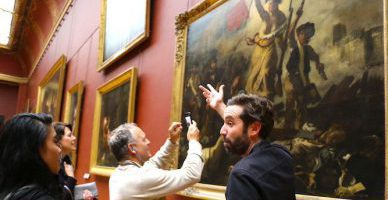



Top-Rated Tour
Secrets of the Louvre Museum Tour with Mona Lisa
The Louvre is the largest art museum on Earth and the crowning jewel of Paris, which is why it’s on everyone’s bucket list. Don’t miss out on an incredible opportunity! Join a passionate guide for a tour of the most famous artwork at the Louvre. Skip-the-line admissions included.
See Prices
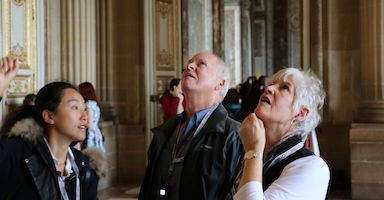


Likely to Sell Out
Ultimate Palace of Versailles Tour from Paris
Versailles isn’t that difficult to get to by train, but why stress over the logistics? Meet a local guide in central Paris who will purchase your train tickets and ensure you get off at the right stop. Then enjoy a guided tour of the palace and the unforgettable gardens. Skip-the-line admissions included to the palace and gardens.
See Prices
Not ready to book a tour? Find out if a Louvre Museums tour is worth it.
15. The Pastoral Concert
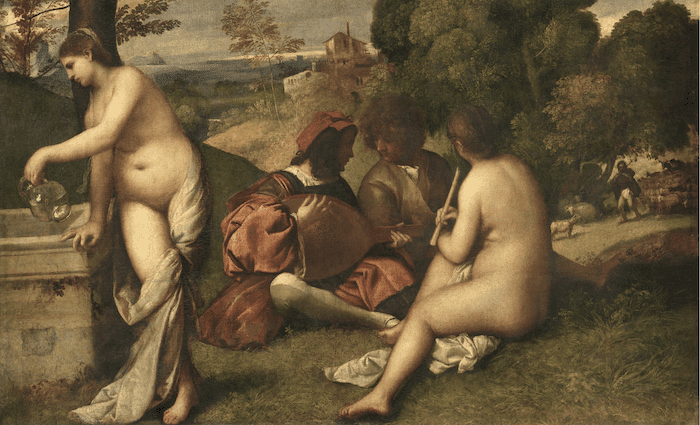

Titian | Oil on Canvas | 1509 | Denon Wing, Room 711
The Pastoral Concert by Titian is symbolic of many things but it is a fantasy above all else. In a time when most people were illiterate, symbolism in paintings is what constructed stories for observers. If you had been alive in the 16th century, you’d know that the two nude women were magical visions.
Admittedly, this doesn’t make much sense to me either, but the fact that they are holding a flute and pouring water in the nude signifies they are illusions. How did people know what these symbols stood for? Much the same way we all seem to know what the “?” symbol means, among others.
Things were no different in the artwork and equally as erotic. Technology may have advanced but our sense of humor is much the same. They are figments of the two men’s imaginations and, at the time, would be supermodels of the time. The allegory could mean different things, which leaves a lot up to the viewer.
14. Minerva Expelling the Vices from the Garden of Virtue
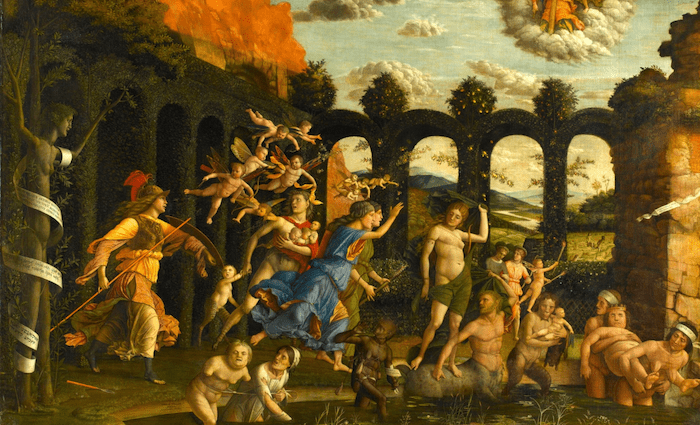

Andrea Mantegna | 1500-2 | Oil on Canvas | Dept of Paintings, Room 371
Andrea Mantegna’s depiction of Minerva Expelling the Vices from the Garden of Virtue is a truly epic painting full of symbolism and action, which is why it makes my list.
You’ll often read about or watch TV series spelling out the sexual pestilence of the Italian Renaissance within noble families, which is likely accurate. This epic painting would serve as a triumphant reminder that those feelings are “wrong” in the light of dogma and should heroically be expelled!
Sexual desire is one of many vices to be expelled. The three vices personified by three fat awkward men on the lower right are avarice, ingratitude, and ignorance. Two men, one with breasts, carry the third wearing a crown with a look of stupidity and drunkenness.
Minerva rushes in with a spear in hand to expel these malformed vices from the courtyard or swamp—just in the nick of time, as a centaur was about to rape Diana the goddess of hunting and fertility.
There is no end to the symbolism and hidden meaning in this painting, which “opens up” over time like a fine wine. Look at the hidden faces in the clouds and Boticelli-like trees with faces.
Mantegna was Venetian, which you can tell just by looking at the extremely bright colors in the painting—bright colors were the style in Venice. There’s another bright Venetian painting on this list, so keep your eyes peeled for it. Mantegna was also over 70 years old when it was completed!
13. The Virgin, Saint Anne, and the Child Playing with a Lamb
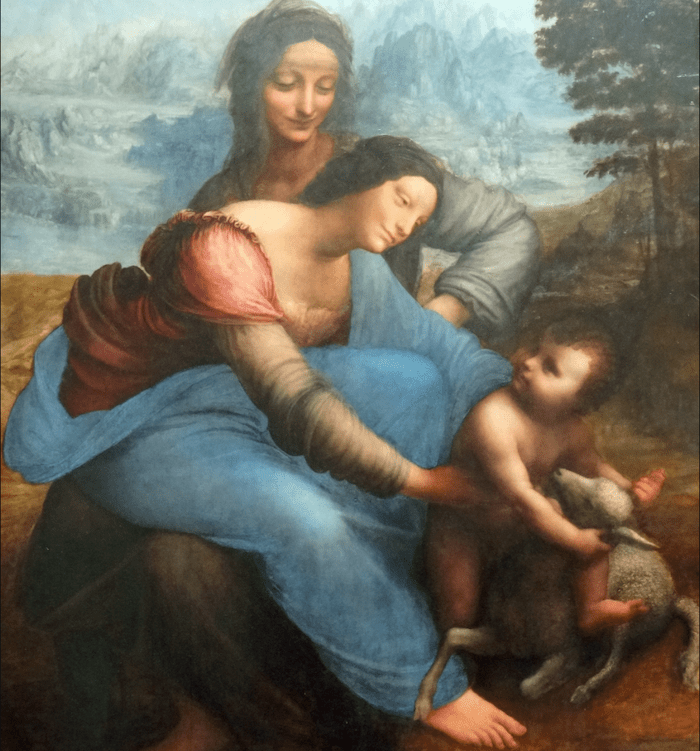

Leonardo da Vinci | Oil on Wood | 1503-19 | Denon Wing, Grand Galeriè 710 – 16
The Virgin, Saint Anne, and the Child Playing with a Lamb is considered a technical masterpiece for da Vinci, especially at the time of completion. Pilgrims flocked to see it upon completion and have been coming ever since because of its complexities. Take a moment to enter the mind of an observer in the 16th century as life was so very different.
Art was their only opportunity to personify figures like Saint Anne and the Virgin Mary to gain a mental picture. Today, you can do a simple search and see the faces of virtually anyone on Earth. The detail that da Vinci gave so many provided a much-needed and far superior personification of key religious figures that were worshiped daily.
Da Vinci created a triangular group of figures, which keeps your eyes moving up and down straight lines and holds your attention. The smiles of Anne and the Virgin captivate and warm you, which is also what the Mona Lisa is so famous for.
Many would rank this painting higher but I believe the greatest artwork must have more depth in the story it tells and its impact on history.
Nearby Da Vinci Works:
25% of all Leonardo da Vinci paintings are in the Louvre Museum. Here are some others you should see nearby:
- Saint Anne, the Virgin, and the Child Playing with a Lamb
- La Belle Ferronière
- Portrait of Isabella d’Este (unfinished)
- Saint John the Baptist (particularly notable)
- La Giocanda (the Mona Lisa—listed below)
12. The Battle Between Love and Chastity
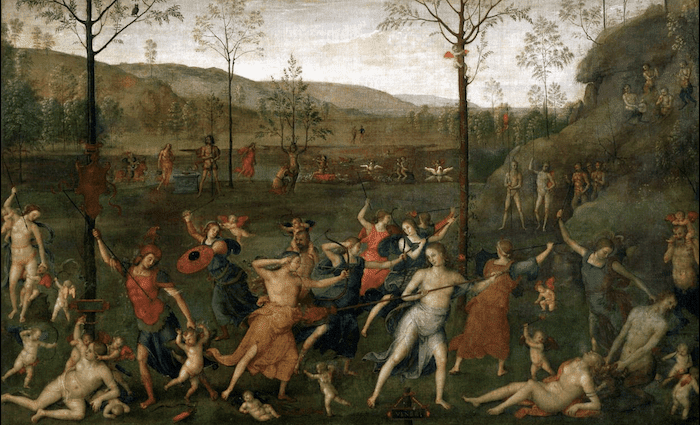

Perugino | 1505 | Oil on Canvas | Department of Paintings
The Battle Between Love and Chastity is an allegory depicting the internal battle our European ancestors faced. Do you save yourself for a loveless marriage or enjoy sexual freedom now?
Modern society does not demand chastity leading up to marriage like it did in the 15th and 16th centuries, which is why we may not understand The Battle Between Love and Chastity. Arranged marriages between people who do not yet love each other are no longer part of Western culture either, which makes this painting even further from our reality.
It was painted by Perugino whose name you may not recognize, but he has work in the Sistine Chapel, believe it or not. It is simply out-shadowed by Michelangelo’s vault and Last Judgement, but beautiful nonetheless.
Pietro Perugino’s painting connects us with that struggle, which is why I believe it is one of the most important and famous paintings in the Louvre. Importantly, it helps us understand the minds of women in the 16th century.
11. La Gioconda (Mona Lisa)
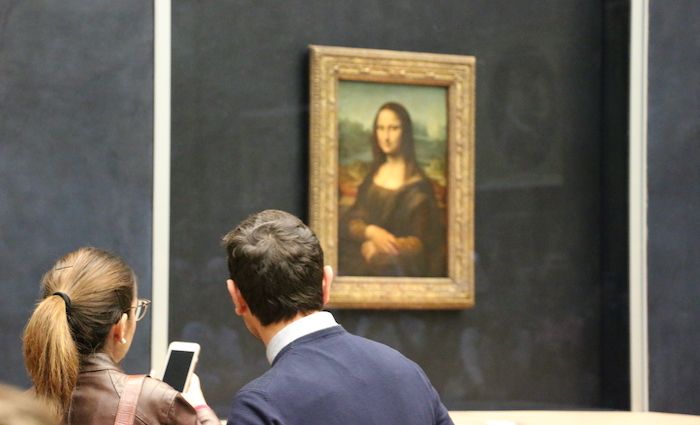

Leonardo da Vinci | Oil on Wood | 1503-5 | Denon Wing Room 711
In terms of pure fame, yes, the Mona Lisa belongs in first place on this list. However, in terms of artistic importance, eleven feels like a compromise and I will explain why.
It is simply a portrait, which as an art form is not meant to go on to international fame—da Vinci would likely agree if he were alive today. It may even be one of the greatest portraits next to Raphael’s Girl Holding a Unicorn and in front of Thomas Gainsborough’s Blue Boy, but it’s still only a portrait.
Portraits are intended to preserve the image of a human in time for their future kin. You likely already know the story, but La Gioconda gained its fame when it was stolen and brought “home” to Florence by an Italian janitor in the early 20th century.
The issue was, the painting was already “at home” in France. Napoleon stole troves of artwork when he conquered Italy and brought it back to the Louvre for display. However, the Mona Lisa was already in France at the time. It was acquired in 1518 by King Francis I.
The news of a da Vinci painting being stolen reached international fame, regardless of which one as there were so few left from the great maestro. When it was found and returned to the Louvre, everyone just had to go see the “returned Mona Lisa, da Vinci’s masterpiece.” So, like everything else, we can blame its mysterious fame on the media and fake news!
Popular Paris Tours
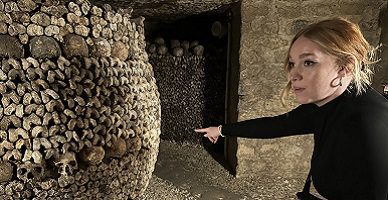

Best-Selling Tour
Paris Catacombs Tour with Secret Rooms & Privileged Access
The Paris Catacombs are unlike most attractions you can visit since it’s an underground burial ground with 6 million skeletons adorning the walls. Learn the deep history here with our English-speaking guide for an experience of a lifetime. Skip-the-line admissions and access to exclusive areas that the public can’t access make this the best tour of the Paris Catacombs.
See Prices




Top-Rated Tour
Secrets of the Louvre Museum Tour with Mona Lisa
The Louvre is the largest art museum on Earth and the crown jewel of Paris. You could spend days here, but instead, join a passionate, English-speaking guide for a tour of the most famous artworks. View the Mona Lisa, the Coronation of Napoleon, Winged Victory of Samothrace, and so much more.
See Prices
Not ready to book a tour? Check out our Louvre Guide for more resources.
10. “The Battles” of the Granicus River
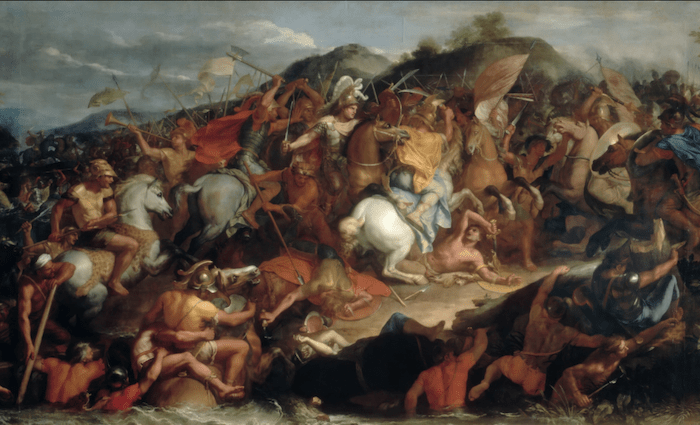

Charles Le Brun | Oil on Canvas | Dept. of Paintings, Louis XIV Collection
Charles Le Brun was the preferred painter of King Louis XIV who commissioned four paintings of epic proportions. When I first stood in front of one of these four paintings, The Battle of the Granicus River, I immediately thought of The Room of Constantine in Raphael’s Stanze in the Vatican Museum.
The detail appears so similar to the fresco of the Battle of Milvian Bridge where Constantine defeats Maxentius. After I did more research, I learned that this was exactly what Louis XIV was looking for—he wanted to compete with Italy in terms of art.
The group of paintings depicts the great battles of Alexander the Great to whom Louis XIV modestly compared himself. In my article on the most famous statues in the Louvre, you’ll see his commission of Alexander and Diogenes.
9. The Virgin of the Rocks
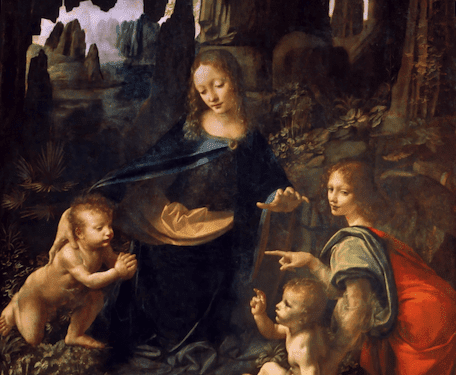

Leonardo da Vinci | Oil on Wood | 1483-86
The Virgin Mary sits on “rocks” with three other figures—hence the name. To her right (our left) is John the Baptist kneeling under her protective arm. There is another older figure across from John pointing at him. That is the angel Uriel who is of orthodox decent and considered the “fourth Archangel” in eastern Christianity.
Below the archangel is Christ as a baby. The beauty of the painting and why I believe it is second only to da Vinci’s Last Supper lies in a few key areas. First, there is a second almost identical painting in London with a few key differences, which is a “Leonardo” thing to do. The London painting does not have Uriel’s finger extended and the colors are different. It may sound like a small detail, but think about how much controversy Judas’ extended finger in the Last Supper gets.
That brings me to my second point—the flow of the painting. The figures create a triangular shape that sends the eyes moving from place to place. Your eyes may be drawn to many points of the painting, but there is a never-ending movement from the hand of Uriel, to John, to Mary, and back again.
The third point is the soft features of each person’s face. When this was revealed, it would have been like comparing the picture clarity from an 80s film to one from this year. Da Vinci was that good at drawing the figures.
Finally, look at the background full of jagged rocks and the Lord-of-the-Rings-like landscape. Why put them there in this magical world? Just like social media today, da Vinci’s goal was to captivate you and steal your attention.
8. St. Michael Overwhelming the Demon
Raphael | Oil on Wood Transferred to Canvas | Grande Galeriè Room 710, 12, and 16
Raphael was one of the most influential artists of the Renaissance. Had he lived longer than 37 years old, he would have accomplished much more. However, his impact was vast for his short time on Earth. Unlike Michelangelo and da Vinci who spent much of their time alone with a few key students, Raphael led armies of artists.
St. Micheal is an archangel and the right hand of God sent to protect humans. The image is one of the most powerful stories of the Bible in which Micheal defeats Satan and casts him into hell on behalf of God.
Nearby Raphael Works:
- Portrait of Doña Isabel de Requesens y Enriquez de Cardona-Angelesola
- Portrait of Baldassare Castiglione (Returns to Louvre Feb 2021 – Room 711)
- La Belle Jardinière—The Virgin and Child with the Young Saint John the Baptist
7. Dante and Virgil in Hell
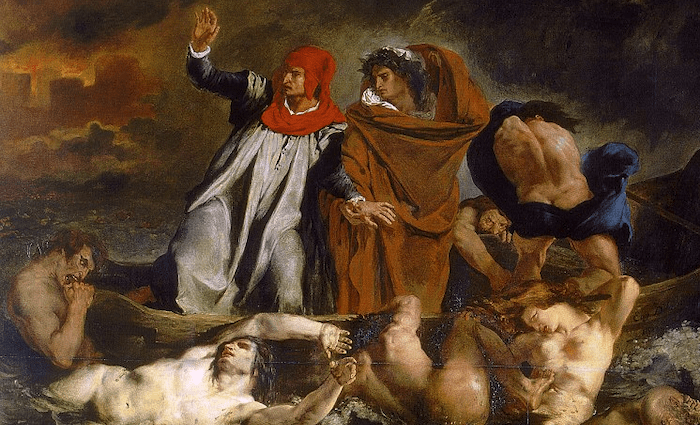

Eugène Delacroix | Salon of 1822 | Oil on canvas
Dante Alighieri, 1265 – 1321, is considered the most influential writer or poet of the early Renaissance. He wrote an epic poem in the nascent Italian language, the Divine Comedy, which essentially put literature back on the map. He wrote the first great book since the fall of the Roman Empire 700 years earlier.
The Divine Comedy is an epic poem divided into three chapters detailing Heaven, purgatory, and hell. Delacroix’s painting depicts hell, which is among the most interesting since virtually every person on Earth is afraid of it.
An interesting point to note is that your fear of hell is due to the Divine Comedy and paintings describing it similar to that of Delacroix. Dante was among the first to describe hell in vivid detail and art converted those descriptions into imagery, which is why we are afraid of hell in the first place.
This was Delacroix’s first major painting and it was immediately accepted and praised by those who favored the romantic movement. It is a passionate allegory featuring Dante in his red cap alongside Virgil, a Roman pagan poet, who gave him the first guided tour in history—a tour of hell!
If you’ve been to the Sistine Chapel, you can see the influence Michelangelo had on Delacroix. With almost 300 years between them, Michelangelo was as ancient to him as he is to us but his impact was great. The “condemned” are featured as large muscular figures strewn about in the water barely alive but far from dead and the minions are shown as more aggressive yellow figures gnawing on the side of the boat and generally striking fear in the eyes of all around.

Watch this video on YouTube
6. The Wedding Feast at Cana
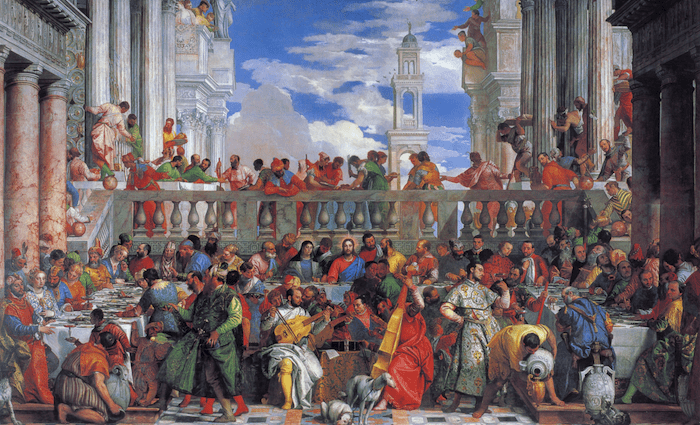

Veronese | Oil on Canvas | 1563 | Dept of Paintings
The Wedding Feast at Cana is a painting of epic proportions. It depicts a scene from the Bible where Jesus turned water into wine at Mary’s request.
In the Bible, this scene would have looked much different. There would have been beggars present in comparison to those in attendance in Veronese’s version, but that’s what makes it so epic. Veronese was from the Venetian school of arts and held a colorful Venetian style, which is visible in this work which may well be his masterpiece.
The setting obviously took inspiration from Raphael’s School of Athens and the seating arrangement from da Vinci’s Last Supper. Similar to the last supper, the guest list included many noteworthy people: Francis I of France, Vittoria Colonna, Mary I of England, Giulia Gonzaga, and other Italian nobles. Veronese depicts himself in his great work as a musician in a white tunic.
5. David with the Head of Goliath
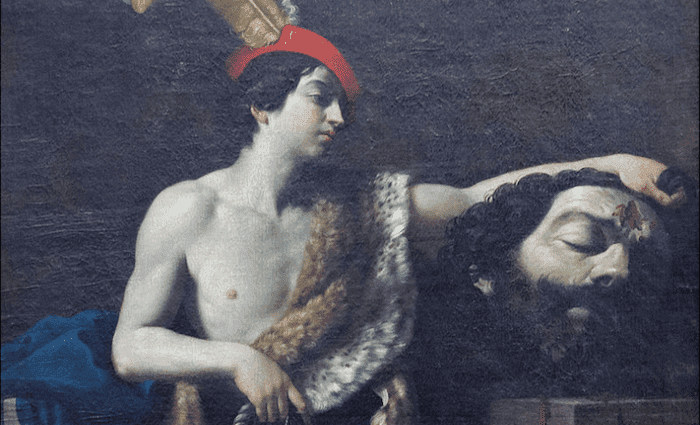

Guido Reni | 1606 | Oil on Canvas | Grande Galarie
Guido Reni was a brilliant late-Renaissance, early-Baroque artist who brought canvas painting to a new level and this painting is proof of that. The epic tale of David (about to be chosen King) beheading the giant Goliath is a common scene in paintings and sculptures for a few reasons.
First, everyone wants to depict themselves as David. Also, it is one of the greatest stories in all of the Bible. The New Testament condones less war, which makes it less popular among ambitious men. On the contrary, the Old Testament is full of war and ambition—at least when speaking of the prophets.
This painting personifies the style of Guido Reni. David has a youthful look with clean soft skin. His garb is rich in color and texture, which beautifies the painting while his hat and feather create perspective and depth. David is featured after the act of killing Goliath so he is void of anticipation but instead contemplates the event and aftermath. What is to come for young David the shepherd?
4. Death of the Virgin
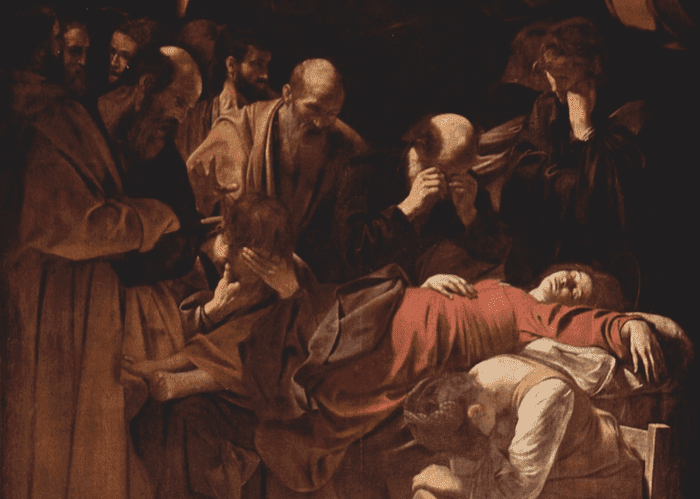

Caravaggio | Oil on Canvas | 1601-06 | Denon Wing, Room 710, 12, and 16
Why is Caravaggio’s Death of a Virgin this far up the list? The painting was first commissioned for Santa Maria della Scala in Rome but it was refused. Never heard of a painting being refused after its commission? If so, do more research on Caravaggio!
The painting was likely refused due to its vulgarity. Christ and the Apostles did not know wealth and this painting accurately depicts that. Caravaggio often paid beggars, prostitutes, and anyone in poverty to model for him. He lived a tragic and toxic life, which is extremely clear in his art.
His depiction of the queen of Christendom’s scene is very likely more accurate than any other account. Its raw emotion, bare feet, somber expressions, and colorless body of Mary did not fulfill the fantasy of the Virgin’s final moments on Earth and thus it was cast away.
You can see the very emotion on the Apostle’s faces as they look at her full of doubt. The last connection to the savior Jesus Christ had passed and now they are alone. There is Mary Magdeline to her side with her head in her hands. A symbol of doubt and uncertainty that is shared with two other apostles.
Peter is likely at her side behind the two doubtful and sad apostles. It is hard to truly know since the normal symbolism of the keys to heaven are not in his hands. That said, the figure has a face of urgency and confidence. Peter was the successor to Jesus and the first pope. It would be his job to bring the group together.
3. Coronation of Napoleon
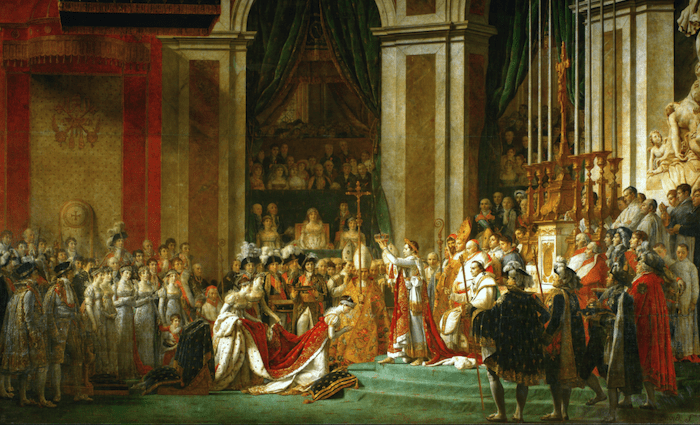

Jacques-Louis David | Oil on Canvas | Dept of Paintings, Daru Room 702
Jacques-Louis David is known as the first painter of Emperor Napoleon. His very first commission ranks third on my list of the most important and famous paintings in the Louvre museum. If it is one of the most important paintings in the Louvre, it is subsequently one of the most important paintings on Earth.
The painting is a massive work at approximately 30 feet by 22 feet. This means you can hone in on the individual expressions of each person. David had his work cut out for him with the smaller-than-other-men but larger-than-life emperor.
First of all, the event happened in Notre Dame Cathedral, which made it extraordinary. Second, the pope himself was there for the event and likely not by his own choice. Napoleon took command of Rome in 1796 after defeating papal troops, which ended in him dragging the pope to France where he died in 1799. The next pope, Pius VII, did not appreciate Napoleon, which can be seen from his somber face in the painting (the only person seated).
Napoleon’s arrogance, to be expected from a true emperor, became evident when he took his crown from Pius VII and crowned himself. He then crowned his beloved wife Josephine the empress by his own hands. The papal investiture in a king was a very big deal for a very long time. That, and the fear of eternal damnation, was what made the pope the King of Kings. Napoleon subordinated the pope by placing the crown on his own head.
Most Important Figures
- Napoleon standing with the Roman victors, crown on his head and the crown of Charlemagne in his hands.
- Josephine kneeling in front of Napoleon with the empress’ crown on her head.
- Pope sitting behind Napoleon looking down with a grimace.
- Napoleon’s mother, sisters, and brothers in the loge playing a secondary role.
Nearby Works by David:
- The Intervention of the Sabine Women—The Sabine women were taken from the Sabine men from the Romans. The women then fell in love with the Romans. When their fathers and brothers came to avenge them, they came in between the lines stopping their kin from fighting their husbands. It’s one of the most epic Roman stories of all time.
- Leonidas at Thermopylae (300)
2. The Raft of Medusa
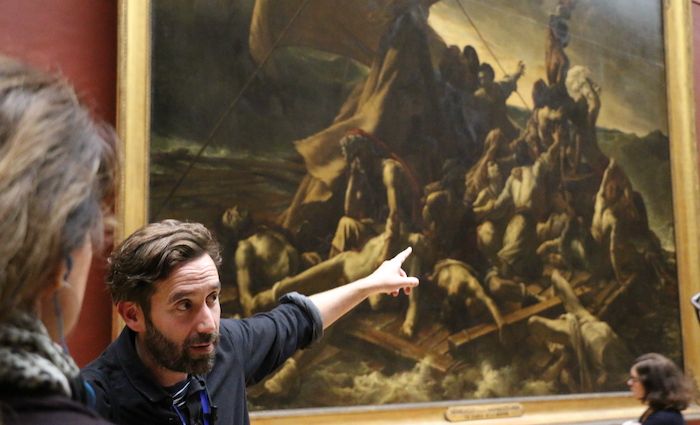

Théodore Géricault | Oil on Canvas | 1819 | Dept of Paintings, Mollien Room 700
The Raft of Medusa was an instant success and brought Géricault to celebrity status. The painting depicts a raft full of people who had suffered a shipwreck. The entire painting curses a French Naval frigate that ignored their plea for help. It outlines the horrors that must have taken place thereafter—things such as cannibalism and hysteria.
This was the apex of French Romanticism, like the Baroque era, romantics favored heavily dramatized scenes with intense stories. Now, on to the number one and greatest painting in the Louvre, in my humble opinion.
Nearby works by Géricault:
- Dante and Virgil in Hell
Our Best Versailles and Paris Louvre Tours




Top-Rated Tour
Secrets of the Louvre Museum Tour with Mona Lisa
The Louvre is the largest art museum on Earth and the crowning jewel of Paris, which is why it’s on everyone’s bucket list. Don’t miss out on an incredible opportunity! Join a passionate guide for a tour of the most famous artwork at the Louvre. Skip-the-line admissions included.
See Prices



Likely to Sell Out
Ultimate Palace of Versailles Tour from Paris
Versailles isn’t that difficult to get to by train, but why stress over the logistics? Meet a local guide in central Paris who will purchase your train tickets and ensure you get off at the right stop. Then enjoy a guided tour of the palace and the unforgettable gardens. Skip-the-line admissions included to the palace and gardens.
See Prices
Not ready to book a tour? Find out if a Louvre Museums tour is worth it.
1. Liberty Leading the People
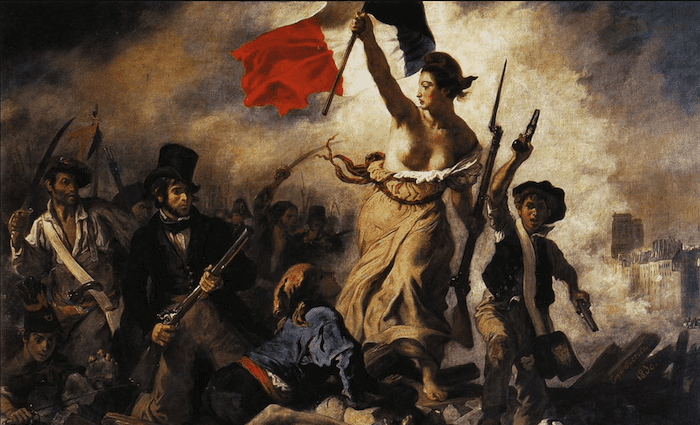

Eugène Delacroix | Salon of 1831 | Oil on Canvas
Delacroix is considered one of the greatest romantic painters of French Romanticism. He was the Bernini or Michelangelo of his time and place, which is why he aces this list.
The painting is an allegory of the 1830 revolution—a pivotal time in France. Liberty is depicted as the bare-bosom centerpiece holding the Tricolore flag of France. This was the flag that the militia bore when storming the Bastille. After the revolution, the Tricolore replaced a blue flag with the gold fleur-de-lis and has been used until today.
The figure, Liberty, is not unique to this image. She stands in the New York / New Jersey Upper Bay outside of Manhattan. Liberty is famous iconography of ancient Greek origin. Her semi-nude appearance is likely a historical reference to ancient Greece. It would be the same figure as the Winged Victory of Samothrace sculpted 2000 years earlier.
The figures alongside Liberty represent all classes fighting together. The man in the top hat is a member of the French upper class. In the same line, there is a factory worker, a student, and people of other professions alongside one another.
It is the greatest painting in the Louvre for a few key reasons. First, Delacroix does an excellent job creating believable human figures, which allows you to get caught up in the emotion of the story. The story is real, passionate, and evokes a feeling—a feeling that it may have happened yesterday and that you are somehow a part of it. It is easily one of the most famous paintings at the Louvre and, in my opinion, the masterpiece of the collection.
Louvre Tours
Did you enjoy the stories behind these incredible works of art? This blog is not meant to replace a guided tour but instead to make it better. Check out our tours of the Louvre led by the most passionate guides in Paris. They’ll undoubtedly elevate your experience.
Not ready to book a tour? Find out if a Louvre Museums tour is worth it.
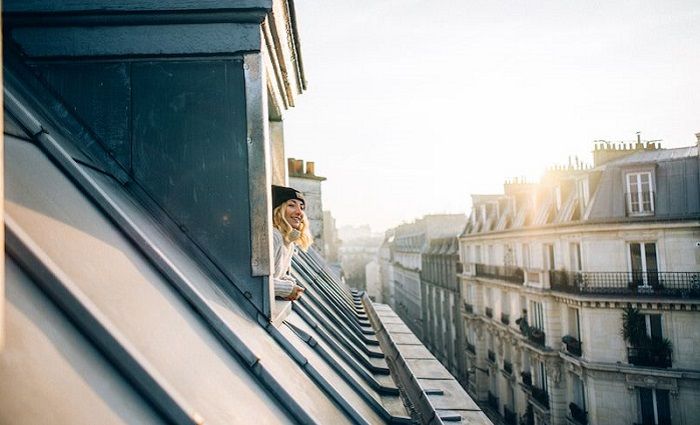

Where To Stay in Paris
With a city as magnificent as Paris, it can be hard to find the perfect hotel at the perfect price. Explore the best hotels and places to stay in these incredible neighborhoods in Paris.

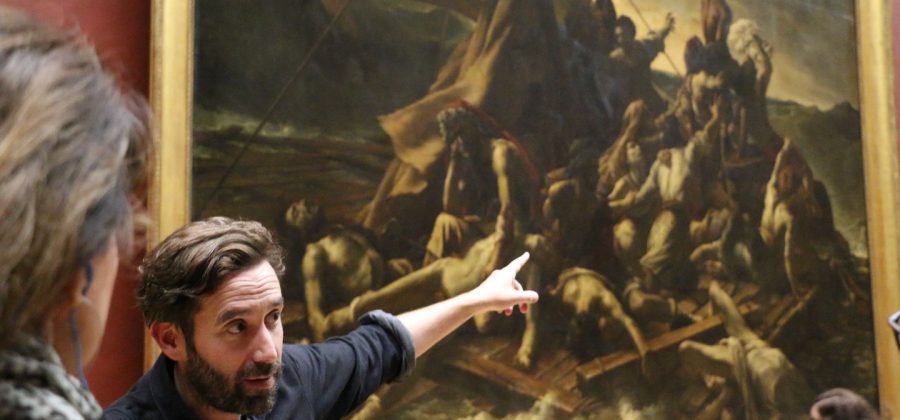
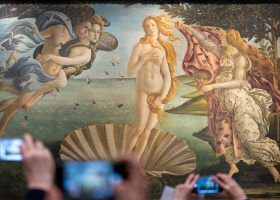
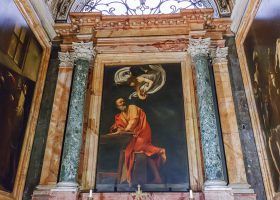
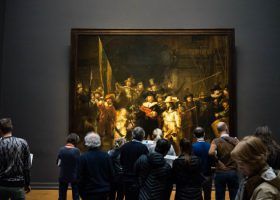
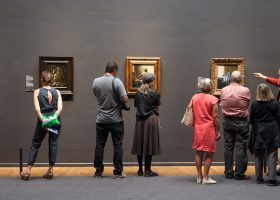
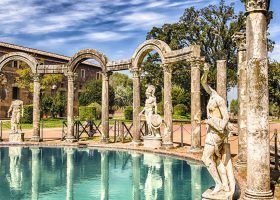
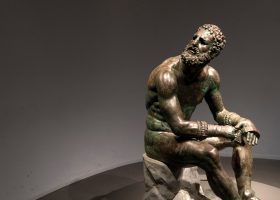


Great discussion of the masterpieces in the Louvre! Thank you.
Thank you for saying Liberty Leading the People is the most important work in the Louvre painting collection. I have been to the Louvre 3 times, and it captures me each time. More magnificent than old Mona Lisa, it captures your heart with possibilities. Beautiful painting
Obviously, a lot of personal preference goes into it, but I believe it has far more depth than the Mona Lisa on a “storytelling” level and is more captivating.